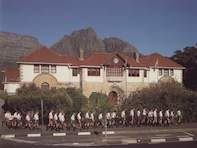Establishing a School
In the latter part of the 20th century the residents of Rondebosch got together to consider the pressing need for a boys' school in their midst.

The initiative for the English-medium school that arose there was spearheaded by the Dutch Reformed Church (DRC) representative of the district, Reverend Bernard PJ Marchand, who set up a management committee for the establishment of what was described as an undenominational first class public school for boys.
Marchand solicited the help of several prominent dignitaries and businessmen, including the Hon WP Schreiner, an Old Boy of South African College (SACS) who became Prime Minister of the Cape Colony (and whose son, Oliver, attended Rondebosch Boys' High and went on to become a noted South African judge), and Sir Lewis Mitchell, general manager of the Standard Bank, to stand guarantee for the initial expenditure that would be required.
Dr Thomas Muir, Superintendent-General of Education, approved a grant of £50 towards the salary and housing allowance for the principal of the boys' public school in 1897. The man chosen for the handsome stipend was Robert MacLennan Ramage, a graduate of Edinburgh University.
Ramage was not without experience of teaching in the flowering new schools of the colony, having been a teacher at Stellenbosch (Paul Roos) Gymnasium before, at the age of 38, taking up the challenge at the new school in Rondebosch.
Opening of Rondebosch Boys High School
In 1897 the school opened as the Rondebosch High School for Junior Boys in Glena Hall, a Dutch Reformed Church building. Ramage's school began modestly, its numbers kept down to the total it could accommodate: just eight pupils. There were 28 boys on the roll, from standards two to seven, and it was decided to open an infant department under the direction of a lady teacher, also of Scottish background, Annie McLachlan.
The first inspection report to Dr Muir, in June 1897, was an encouraging one: 'This school has made a promising commencement and deserves the unhesitating support of the neighbourhood. The accommodation and equipment are both satisfactory. The teaches are able and zealous.'
By August of the same year, the school in the little church hall on Erin Road was attracting a lot of interest, and its name had been changed to the Boys' High School, Rondebosch. Faced with a flush of applications from local residents, the school committee found that it had to become quite selective in its acceptance. And, before the year was out, the committee was looking for a suitable site upon which to build a new, and considerably bigger, school.
When a nearby property, on almost an acre of ground at the corner of Campground and Rouwkoop roads - came up for sale, the committee negotiated a loan with the Standard Bank, bought the property for £1 900, and authorised architect GG Milne to draw up plans for a school building.
Teaching commenced in the new building on The Firs’ site. The school comprised six 'lofty, well lighted and ventilated' classrooms, a verandah running around three inside walls of a quadrangle, an infant department with a moveable glazed partition, and private rooms for the headmaster and teachers. Mr Ramage moved into a cottage on The Firs' site, where he continued to direct the rapid growth of the school. In 1899 it was elevated in status by the addition of extra classes up to matriculation standard.